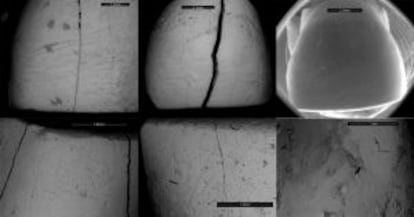Neanderthals divided tasks by gender, Spanish research study reveals
Dental evidence points to fact that males and females performed different jobs

For years now, the Neanderthals have been forcing Homo sapiens to eat humble pie again and again. A species that we once wrote off as primitive and brutish was in fact so similar to ours that thousands of years ago we even turned them into our sexual partners, and into the early fathers and mothers of our own children.
Recent findings show that the Neanderthals also had a culture of their own, producing drawings and using decorative elements and symbols, which all denote complex thought.
And now, new research has unveiled another similarity between our own species and those distant cousins who became extinct around 35,000 years ago: they, too, divided labor by gender.
Individuals used their mouths as a third hand, using their teeth to hold pieces of meat that they then cut with stone tools
Previously, researchers had found evidence that Homo sapiens hunter-gatherer societies had divided jobs by sex, something that a few modern groups still do, such as the Hadza people from Tanzania.
Such evidence can be found in teeth: individuals used their mouths as a third hand, using their front teeth to hold pieces of meat that they then cut with stone tools. Occasionally the tool would hit the teeth and leave a characteristic mark, which paleoanthropologists now use to analyze the “cultural” uses of this third hand.
Several studies on primitive Homo sapiens and modern African hunter-gatherers show these marks are different on men and women, providing proof of job specialization.
Antonio Rosas and Almudena Estalrrich, researchers at Spain’s National Museum of Natural Sciences (MNCN-CSIC), have now found similar markings on the teeth of Neanderthals who lived in Asturias in northern Spain, France and Belgium around 49,000 years ago.

In a paper published in the Journal of Human Evolution, the researchers describe their analysis of 99 incisors and canine teeth from 19 Neanderthal male and female individuals of various ages. The largest sample was found in El Sidrón cave, in Asturias, where DNA analysis confirmed their gender. The other samples are taken from sites in l’Hortus (France) and Spy (Belgium).
Results show that, in general, women’s teeth have longer striations than men’s. The researchers also found gender differences in dental chipping in connection with the way teeth were used to hold objects.
The study suggests that all individuals probably used the same kinds of tools, but worked with different materials (such as soft or tough meat) and for different periods of time. This “could mean that there was a division by sex,” say the authors.
With studies already having showed that the Neanderthals exhibited much more complex behavior than initially believed – they had symbols, used plants for medicinal purposes and even mated with Homo sapiens – this work contributes new insight into the “modern behavior” of the species, the authors conclude.
“This is a very stimulating study,” said María Martínón-Torres, an expert in hominid teeth at the National Research Center on Human Evolution in Burgos, northern Spain. She underscored the importance of the Spanish site, where many quality teeth samples used in the research were found. “The most complicated part now is explaining the mechanism by which the women ended up with different marks.”
“One possibility may lie in dexterity or strength: women, being less strong, may have needed to make more cuts, and thus have more teeth marks,” she added.
Martinón-Torres, who did not take part in the research, suggested studying modern hunter-gatherers for clues.
Tu suscripción se está usando en otro dispositivo
¿Quieres añadir otro usuario a tu suscripción?
Si continúas leyendo en este dispositivo, no se podrá leer en el otro.
FlechaTu suscripción se está usando en otro dispositivo y solo puedes acceder a EL PAÍS desde un dispositivo a la vez.
Si quieres compartir tu cuenta, cambia tu suscripción a la modalidad Premium, así podrás añadir otro usuario. Cada uno accederá con su propia cuenta de email, lo que os permitirá personalizar vuestra experiencia en EL PAÍS.
¿Tienes una suscripción de empresa? Accede aquí para contratar más cuentas.
En el caso de no saber quién está usando tu cuenta, te recomendamos cambiar tu contraseña aquí.
Si decides continuar compartiendo tu cuenta, este mensaje se mostrará en tu dispositivo y en el de la otra persona que está usando tu cuenta de forma indefinida, afectando a tu experiencia de lectura. Puedes consultar aquí los términos y condiciones de la suscripción digital.
Últimas noticias
The complicated life of Francesca Albanese: A rising figure in Italy but barred from every bank by Trump’s sanctions
How Japan is trying to avert ‘digital defeat’
Half of Scotland is in the hands of 420 property owners
From digital curfews to blocking apps: How technology experts protect their children online
Most viewed
- Why we lost the habit of sleeping in two segments and how that changed our sense of time
- Trump’s obsession with putting his name on everything is unprecedented in the United States
- Charles Dubouloz, mountaineering star, retires at 36 with a farewell tour inspired by Walter Bonatti
- The Florida Keys tourist paradise is besieged by immigration agents: ‘We’ve never seen anything like this’
- Living in a motorhome due to soaring housing prices in Madrid: ‘I got used to it quickly, but I don’t idealize it’









































